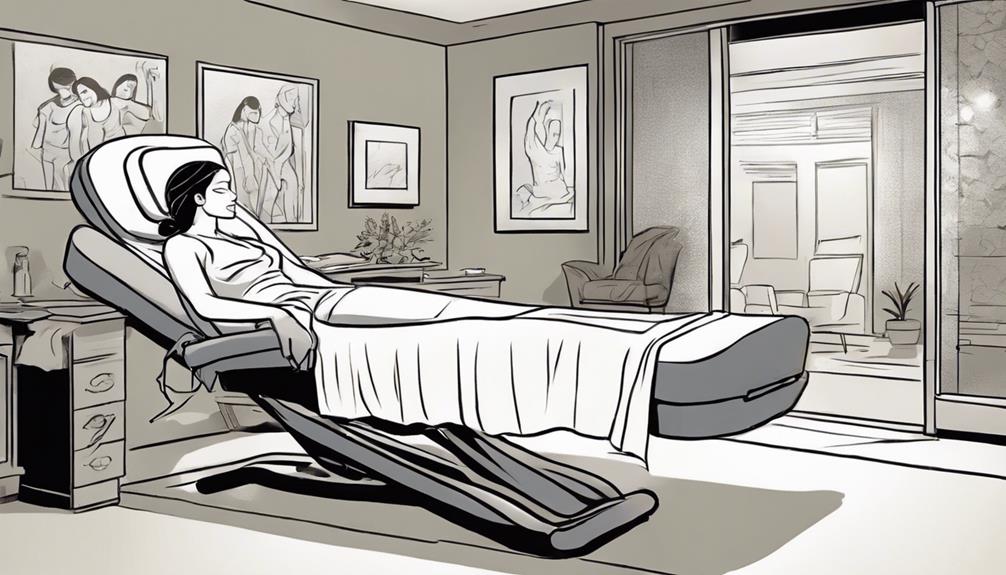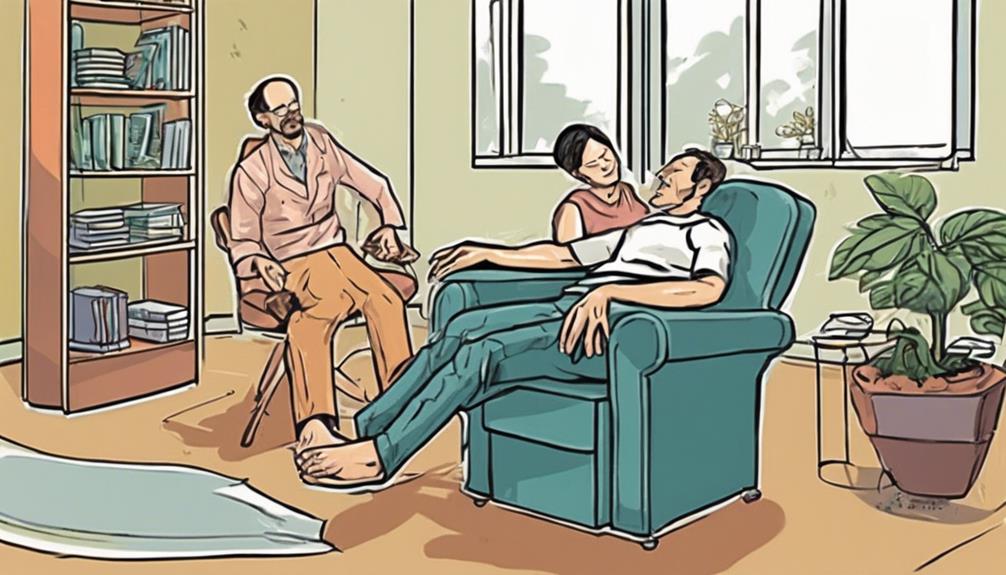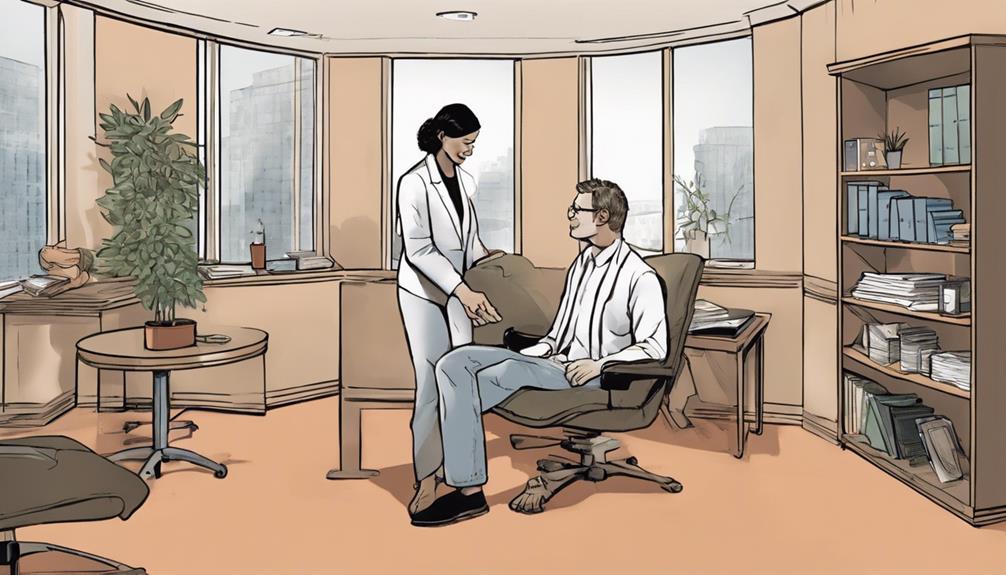Step into a somatic therapy session to connect deeply with your body. Begin with discussing goals and concerns, then shift to comfortable exploration. Engage in gentle movements to increase body awareness, addressing any tension or stored trauma. Feel supported as the therapist creates a safe space for you to participate in dialogue, movement, touch, and decision-making. Experience the power of movement and touch to complete stress cycles and enhance relaxation. Discover the benefits of somatic therapy as you rebuild self-worth and align body and mind. Learn more about the session to reveal further insights into somatic healing.
Key Takeaways
- Initial discussion to set goals and address concerns.
- Transition to a comfortable exploration space.
- Engage in body awareness exercises through gentle movements.
- Address freeze states to promote relaxation and freedom.
- Therapist creates a safe space for dialogue, movement, and touch.
Therapeutic Techniques and Practices

Explore various therapeutic techniques and practices utilized in somatic therapy to enhance healing and promote emotional well-being. Somatic therapy emphasizes body awareness and employs a holistic therapeutic approach that integrates the mind and body.
Through somatic techniques, such as resourcing for strength and grounding in the present moment, individuals can cultivate a deeper connection to their bodies and emotions. This heightened body awareness allows for a more profound understanding of how past experiences manifest physically and emotionally in the present.
Movement is a key component of somatic therapy, as it naturally facilitates healing by engaging the body in actions necessary for releasing tension. By incorporating movement into therapy sessions, individuals can address stored trauma and stress in the body, promoting a sense of release and relaxation.
Somatic work professionals like Dr. Peter Levine and Dr. Pat Ogden have pioneered these therapeutic approaches, providing effective interventions for trauma survivors seeking healing through somatic therapy.
Process and Actions in Session

You'll explore the structure of a somatic therapy session, the therapist's role, and the significance of your active involvement.
The session's flow, the therapist's interventions, and your responses all play a vital part in the healing process.
Understanding how the session unfolds can enhance your experience and promote growth.
Session Structure Overview
The structure of a somatic therapy session involves initial conversations, moving to the table, and engaging in body awareness exercises.
Here's what you can expect during a session:
- Initial Conversations: Your therapist will start by discussing your goals, concerns, and any physical or emotional sensations you may be experiencing.
- Transition to the Table: You'll then be guided to the therapy table where the session will take place, allowing for a comfortable space for exploration.
- Engaging in Body Awareness Exercises: Through gentle physical movements and touch, you'll be encouraged to tune into your body's sensations and explore areas of tension or discomfort.
- Addressing Freeze States: The therapist will observe your body language and movements, guiding you towards releasing freeze states and promoting relaxation and freedom in your body.
In a somatic therapy session, these structured elements work together to help you connect with your body, emotions, and overall well-being.
Therapist's Actions
In a somatic therapy session, the therapist takes on the role of listening, observing, and creating a safe environment for the client's exploration of body awareness and emotional well-being. Throughout the session, somatic therapists engage with clients in various ways to facilitate healing and growth. Below is a table outlining key actions taken by somatic therapists during a session:
| Therapist's Actions | Description | Purpose |
|---|---|---|
| Listen | Attentively hear and understand the client's words | To empathize and gain insight into the client's needs |
| Observe | Notice body language, tension, and movements | To assess the client's somatic responses and emotions |
| Create Safe Space | Establish an environment free of judgment and fear | To encourage openness and trust for the client's exploration |
Client Participation
Active involvement is essential in somatic therapy sessions, where clients engage in various exercises to address physical and emotional discomfort. During the session, your participation plays a pivotal role in the healing process.
Here's how you can actively engage:
- Dialogue: Share your thoughts, feelings, and experiences with the therapist to help guide the session towards areas that need attention.
- Movement: Participate in body awareness exercises and gentle movements to explore and release tension held in the body.
- Touch: Allow yourself to experience gentle touch as a way to connect with your body and emotions, facilitating the healing process.
- Decision-Making: Make choices that promote ease and freedom in your body, with the therapist's support and encouragement to guide you along the way.
Role of Movement and Touch

You engage in movement and touch during somatic therapy to complete stress responses and release cortisol and adrenaline.
Various forms of movement are employed to help you release stress and elicit a primitive response in your body.
Movement as Therapy
Engaging in purposeful movement and touch serves as integral components of somatic therapy, actively aiding in stress release and promoting a sense of safety for clients.
Here's how movement functions as therapy in somatic sessions:
- Completing the Stress Response Cycle: Movement in somatic therapy helps release cortisol and adrenaline, essential for completing the stress response cycle effectively.
- Activating Primitive Responses: Touch and movement play an essential role in activating primitive responses, aiding in the release of traumatic stress stored in the body.
- Addressing Physical Manifestations of Stress: Somatic therapy focuses on addressing physical manifestations of stress, assisting clients in responding more effectively to non-survival stressors.
- Encouraging Ease and Freedom: By encouraging movement and addressing freeze states, somatic therapy guides clients towards making choices that promote a sense of ease and freedom in their bodies.
Importance of Touch
Touch serves as a pivotal element in somatic therapy sessions, facilitating a deep connection with the sensations in your body. Through touch, somatic therapists can help you tune into and process the emotions and stress responses stored within your body. This tactile approach allows for a more profound exploration of your physical and emotional experiences, leading to a deeper understanding of yourself.
| Importance of Touch in Somatic Therapy Sessions | |
|---|---|
| Facilitates Connection | Touch helps establish a strong connection with your body's sensations and emotions. |
| Release of Stress Responses | Movement and touch work together to release stored stress responses, aiding in the healing process. |
| Address Freeze States | Hands-on components in sessions address freeze states, promoting a sense of safety and support. |
| Promotes Relaxation | Touch and movement techniques aim to address physical manifestations of stress and promote relaxation. |
Addressing Stress Responses

Addressing stress responses in somatic therapy involves tapping into the body's memory and engaging in physical movements to complete stress cycles. By utilizing techniques like Somatic Experiencing (SE), clients can effectively regulate their body's responses to stress.
Here are four key aspects of addressing stress responses in somatic therapy:
- Recognition of Physical Manifestations: Somatic therapy helps individuals identify and understand how stress manifests physically in their bodies, such as muscle tension or shallow breathing.
- Completion of Stress Cycles: Through physical movements and expressive techniques, clients can release built-up cortisol and adrenaline, completing stress responses to promote relaxation.
- Navigating Freeze States: Somatic therapy assists clients in recognizing freeze responses and supports them in choosing responses that lead to feelings of safety and freedom.
- Enhancing Present-Moment Awareness: By engaging in dialogue, movement, and touch during sessions, individuals can cultivate awareness of their present experiences and regulate their stress responses more effectively.
Benefits and Healing Effects

Reaping the rewards of somatic therapy sessions involves opening a pathway to rebuilding self-worth and releasing suppressed emotions, ultimately aligning body, mind, heart, and soul. Through the guidance of skilled therapists like Peter Levine, these sessions offer a range of benefits and healing effects that can transform your well-being.
Here is a table summarizing some key benefits and healing effects of somatic therapy sessions:
| Benefits | Healing Effects | Keywords |
|---|---|---|
| Rebuilding self-worth | Addressing body tension | Peter Levine |
| Releasing emotions | Exploring facial gestures | Nervous system |
| Aligning body & mind | Dialogue, movement, touch | |
| Living fully embodied | Present-moment awareness |
Integration of Body Awareness

During somatic therapy sessions, shifting your attention to bodily sensations plays an essential role in integrating body awareness.
Here's what you need to know about the integration of body awareness:
- Focused Attention: By honing in on bodily sensations, you engage your cognitive brain functions, fostering a deeper connection between mind and body.
- Trauma Resolution: Regulating the nervous system through body awareness is a key component in the process of trauma resolution, helping individuals heal from past experiences.
- Holistic Healing: Balancing verbal communication with bodily narratives during sessions allows for a more all-encompassing approach to healing, addressing both mental and physical aspects.
- PTSD Relief: Calming the body through body awareness practices can gradually unravel the sense of being stuck that often accompanies post-traumatic stress disorder (PTSD), promoting a sense of release and relief over time.
Overcoming Fear and Discomfort

To conquer fear and discomfort during somatic therapy sessions, it's essential to gradually acclimate to body sensations and cognitive explorations. If you're feeling uneasy, therapists can start by focusing on cognitive aspects before delving into physical sensations.
By easing into the process, you can build a foundation of trust and safety within the session. Therapists keenly observe your behavioral cues, guiding you through internal sensing systems to create a new, positive experience distinct from past trauma.
Monitoring for signs of nervous system overwhelm is pivotal to regulate the session effectively, preventing re-traumatization and ensuring a healing environment. The primary goal is to foster body awareness and engage in somatic experiencing techniques to help you process and overcome fear and discomfort.
With patience and guidance, you can navigate these emotions, gradually enhancing your comfort within the somatic therapy space.
Types of Therapy Sessions

Different types of therapy sessions in somatic therapy can be conducted in person, online, or via phone to cater to various preferences and needs. When engaging in somatic therapy, you have the flexibility to choose the session format that aligns best with your comfort and circumstances.
Here are some common types of therapy sessions:
- In-Person Sessions: Traditional face-to-face sessions where you interact directly with the therapist, allowing for a more immediate connection and hands-on somatic interventions.
- Online Sessions: Virtual sessions conducted through video calls, providing convenience and accessibility while still enabling a meaningful therapeutic experience focused on the body and spirit.
- Phone Sessions: Sessions conducted over the phone, offering a more auditory-focused approach to exploring somatic experiences and promoting healing through verbal communication.
- Somatic Experiencing (SE) Sessions: Specialized sessions led by certified professionals who guide you in reconnecting with your body and spirit, emphasizing body awareness to address trauma and promote holistic healing.
Professional Development and Training

Engaging in professional development and training in somatic therapy is essential for enhancing your therapeutic skills and knowledge in body-focused healing. By participating in training opportunities, you can't only expand your understanding of somatic therapies but also connect with like-minded professionals in the field of body-focused interventions.
Courses and workshops offer an in-depth exploration into various somatic techniques aimed at promoting holistic healing and personal growth. These resources often include downloadable worksheets, mindfulness activities, and hands-on experiential learning opportunities to enrich your practice.
Leading experts in somatic therapy, such as Dr. Peter Levine and Dr. Pat Ogden, provide specialized trainings to help you deepen your understanding and application of somatic interventions. By investing in continuous professional development, you can stay abreast of the latest advancements in somatic therapies, refine your therapeutic approach, and ultimately offer more effective and thorough care to your clients.
Frequently Asked Questions
What Does a Somatic Experiencing Therapy Session Look Like?
In a somatic therapy session, therapists guide you to track bodily sensations, regulate your nervous system, and address trauma. It involves balancing talking and body work without needing to disclose detailed traumatic events for healing.
What Is an Example of a Somatic Experience?
In a somatic experience, you may explore bodily sensations to regulate your nervous system and address trauma. Therapists guide you in focusing on your body, facilitating healing without needing to investigate into specific traumatic events.
What Is an SE Session Like?
In an SE session, you'll dive deep into your body's wisdom, feeling like you're opening a treasure chest of healing. Therapists guide you to explore sensations, soothe your nervous system, and empower your journey.
What Do You Actually Do in Somatic Experiencing?
In Somatic Experiencing, you focus on bodily sensations to regulate your nervous system. Therapists gradually integrate body awareness, balancing talking and body work. Tracking sensations helps regulate your system and resolve trauma, restoring safety, improving emotional regulation, and enhancing resilience.
Conclusion
So, now you know what a somatic therapy session looks like! Picture it like a dance between mind and body, moving through emotions and releasing tension.
Just like a sculptor shaping clay, the therapist helps mold your experience into healing and growth. It's a journey of self-discovery and transformation, where every movement and touch is a step towards wholeness.
Immerse yourself in the depths of your being and let somatic therapy guide you towards a more balanced and harmonious life.










